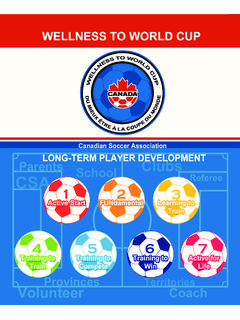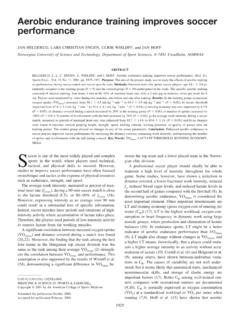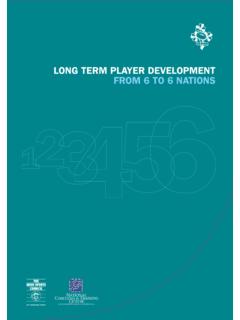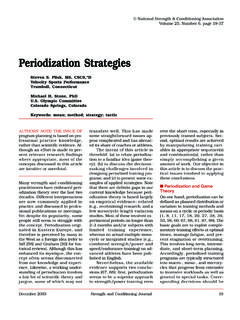Transcription of SECTION - Canada Soccer
1 Canada Soccer PATHWAY: COACH S TOOL KIT STAGE 3: LEARNING TO TRAIN 1 SECTIONCANADA SOCCERPATH WAY: COACH S TOOL KITSTAGE THREE LEARNING TO TRAINW hether they dream of playing for Canada s National Teams or simply want to have fun with their friends, taking the right approach to the game when children are young sets the stage for a lifetime of Canada Soccer Pathway provides a roadmap for players of all ages and aspirations who want to play Soccer at the recreational, competitive or high performance EXCEL levels, with the aim of encouraging lifelong participation.
2 The Pathway is built around the principles of Long-Term player Development (LTPD). For players under the age of 12, many of whom are lacing up cleats for the first time, the goal of this approach is simple:GET KIDS TO FALL IN LOVE WITH THE Soccer BELIEVES EVERY player DESERVES THE BEST POSSIBLE Soccer TO TRAIN(U-8/U-11 F, U-9/U-12 M) This golden age of learning, when children become less self-centered and are more able to reflect on their actions and learn from mistakes, provides an optimal window for further development of skills. The focus is on learning by doing, building a larger repertoire of Soccer movements and teaching the basic principles of play in a fun and challenging THREE: Canada Soccer PATHWAY: COACH S TOOL KIT STAGE 3.
3 LEARNING TO TRAIN 3 TABLE OF CONTENTRole of the Coach 4 Coaching Tips 5 Preferred Training Model 6 Soccer Technique 7 Dribbling 8 Shielding 9 Feint 10 Stepover 11 Scissors 12 Control 17 Passing 22 Shooting 27 Heading 32 General Movement 38 Coordination 43 Coordination - Dribbling 44 Coordination - Control 48 Coordination - Passing 52 Small Sided Games 56 Small Sided Games - Dribbling 57 Small Sided Games - Passing 61 Small Sided Games - Shooting 65 Notes 69A place to make your own personal notesCanada Soccer Pathway 71 ROLE OF THE COACHTHE ROLE OF THE COACHT eacher.
4 Mentor. Role model. Cheerleader. Parent. Occasional coaches wear many different hats, particularly when they re training young players, many of whom are lacing up their cleats for the first time. You might find yourself leading a fun activity one minute and reining in a distracted player the next. You must be flexible, because a session or drill that was meant to last 10 minutes might need to be switched up after half that time to keep the players engaged. Above all, make sure everyone is enjoying the session including you. Being a coach is demanding, but it s also incredibly rewarding.
5 There s nothing quite like witnessing the thrill a young player gets when they score their first goal, or make a fantastic pass. And the lessons a child learns from a good coach can last a lifetime. The objective isn t just to develop better Soccer players it s to develop well-rounded people who are disciplined, persistent and able to work well with others. Shaping the lives of young people is a tremendous responsibility. As a coach, you must do everything you can to foster a player s love for the game, and to help them achieve their potential.
6 Good coaches seek out new ways to develop their knowledge of the game and how players learn. This toolkit is designed to get you started. But it s not just about what you teach. It s about how you teach. Ultimately, it s your personality and enthusiasm that will have the biggest impact on your players. Canada Soccer PATHWAY: COACH S TOOL KIT STAGE 3: LEARNING TO TRAIN 5 SECTION1 Command: The coach tells the player what to do and demonstrates it ( I want you to pass the ball to your partner. ).2 Question & Answer: The coach leads with a question and requests an answer from players ( Which one of your teammates could you pass the ball to?)
7 3 Observation & Feedback: The coach and players observe an activity and discuss the outcome ( Let s watch and see what happens. ).4 Guided Discovery: The coach asks a question and issues a challenge ( Can you show me how you would get the ball past the defender? ). The player then demonstrates how he/she would do Trial & Error: The players and/or coach decide on a challenge, and the players are encouraged to find their own solutions with minimal support from the Soccer PATHWAY:COACHING TIPSE very Soccer player is unique and it s important to understand and appreciate the differences between players at various age levels.
8 When you re planning a training session, consider the group of players you re working with and the outcomes you want to achieve, and choose your coaching method accordingly. In no particular order, here are five coaching techniques that will give you some options to help meet the needs of individual players:Remember, a method that works well with one player may not be effective with another. So it s important to be flexible, to set realistic goals and to give positive feedback as often as possible. It s also important to remember that, no matter how wonderful a coach you are, it s very difficult to force a player to be interested in your training session when he or she really doesn t want to be there.
9 Make the experience lots of fun and all your players will want to come back the next TIPS6 Canada Soccer PATHWAY: COACH S TOOL KIT STAGE 3: LEARNING TO TRAINCANADA Soccer PATHWAY:OUR PREFERRED TRAINING MODELC anada Soccer recommends a station approach to training. Players move from one skill-building activity to the next at regular intervals. The time spent on each activity varies based on the age of the player (see Training Template ).This method is not only more fun for young players who tend to have short attention spans but also allows training sessions to be tailored to a team s individual needs, depending on the number of players, the number of parents and coaches present, and the available training session is built around four activity stations, one focusing on General Movement skills, one on Co-ordination, one on Soccer Technique and another on Small-Sided Games.
10 Addressing all four of these training pillars at each practice session will help develop well-rounded young players with a foundation in physical literacy, solid Soccer skills and, ideally, an enduring love of the TemplateFor players at the Learning to Train stage (U-8/U-11 girls; U-9/U-12 boys), training sessions should be 75-90 minutes long and comprised of:10%10%40%40%General MovementCoordinationSoccer TechniqueSmall-Sided GamesThis tool kit will give you ideas for specific activities under each of the four training pillars. How you set up your training sessions is entirely up to you.







